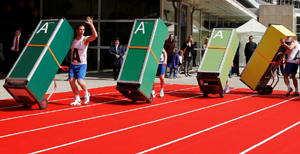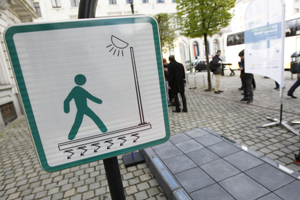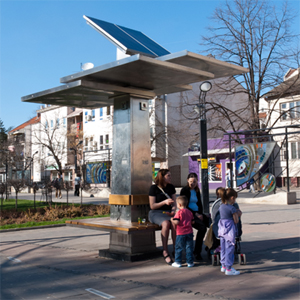Energy comes to Brussels
on
Energy comes to Brussels
They came from far and wide and their achievements were quite impressive. No, this was not a meeting of European heads of state, but the night of the annual EU Sustainable Energy Europe Awards. These may be considered Europe's energy Oscars, where Brussels generously rewards projects from all over Europe for real, measurable reductions in energy use, switching to renewables, or increasing awareness of green energy.
 |
| Labelled fridges raced against each other in front of the Berlaymont. (photo: EC/CE - Patrick Mascart) |
It's hard to pick a favourite, but mine this year is Strawberry Tree, winner in the “Consuming” category (getting consumers to think about their energy consumption and find innovative ways of reducing it). A study in simplicity, the “tree” offers passers-by shady seats beneath a canopy of solar panels, whose power they can use to recharge their mobiles, cameras and i-pods. The brainchild of a Serbian NGO, with a first exemplar installed in Belgrade, the aim is to let people see for themselves what solar energy can do. Keep an eye out for future plantings.
Other winners ranged from the ‘world’s cleanest car plant’, built by Renault on the outskirts of Tangier in Northern Morocco (category Producing), to ‘energy detectives’ (a school programme in Austria ‘empowering student teams to detect wasted energy and to challenge their peers and adults to change bad habits’, in the category Learning) and cycling city counsellors in a town in Germany (category Travelling).
The Award Ceremony was the highlight of the annual EU Sustainable Energy Week, a whirlwind of over 700 events in 44 countries covering every conceivable facet of green energy use and production. The normally quiet halls of the Commission’s Charlemagne building were buzzing with activity and, outside, there was everything from the world’s first electro-active sidewalk (from Toulouse) to a race between seven fridges straining to prove their efficiency!
Not that renewables always have it easy in Brussels. From a new study last month for the Commission’s energy department, it appears that their cost of adapting to climate change is three
| A study in simplicity, the "tree" offers passers-by shady seats beneath a canopy of solar panels, whose power they can use to recharge their mobiles, cameras and i-pods |
Diesel versus Petrol
Sustainable Energy Week is also of course the perfect occasion for new policy announcements. This week, the European Commission made two: one on the longstanding, highly sensitive issue of energy taxation reform and the second on the sexier if complex subject of smart grids.
Taxation of any sort has always been a national prerogative in Europe and successive EU energy taxation laws have taken forever to agree. The last one in 2003 took six years! And the new proposal goes beyond any of its predecessors. For the first time ever, Brussels is proposing to regulate real taxation rates, rather than just set minima that most member states exceed by a mile anyway. The Commission’s proposal says that by 2023 EU member states will have to charge consumers more for diesel than petrol. Currently petrol is the more expensive fuel in most of Europe. The shift derives from a fundamental restructuring of how fuels are taxed – the Commission wants to see motor and heating fuels taxed according to their energy content (how much energy they generate) and CO2 emissions, rather than by volume. In practice this means diesel should cost 15% more than petrol since it generates more energy and emits more CO2 per litre. The German car industry for one is up in arms.
With the power sector and industry more or less covered by the EU Emission Trading Scheme (ETS), transport has received increasing climate scrutiny from Brussels lately. In a long-anticipated white paper on transport, published at the end of March, the Commission already raised the hackles of the
| It seems ironic indeed that renewables are threatened by the very problem they are helping to solve |
Stress-test
 |
| Toulouse electric sidewalk (photo: EC/CE - Patrick Mascart) |
In making his smart grids announcement on Tuesday, Energy Commissioner Günther Oettinger was given brief respite from the Fukushima-affair. With the nuclear threat level raised to that of Chernobyl by the Japanese government, Oettinger could only repeat that it was ‘more important than ever’ that European governments would ‘stress-test’ their own plants. He has become much more careful with his language after more passionate statements about the Japanese disaster last month reportedly triggered stock market tumbles (never mind a lot of irritation in nuclear-is-okay insistent France).
In concrete terms, the only thing Europe did last week in the nuclear arena was to temporarily lower radioactivity limits for food imports from Japan to meet Japanese standards (to reassure a worried European public?). Earlier, Climate Commissioner Connie Hedegaard suggested her 2050 decarbonisation roadmap may require reworking if countries drop nuclear power. Countries could require greater use of fossil fuels and renewables as a result, depending on what is calculated to be the most cost-effective way of meeting EU climate goals. But there is no question of the goals themselves being altered.
Actually, the Commission has become quite reticent on EU nuclear policy recently. The role of nuclear power in a member state’s energy mix is a national prerogative, but Europe has some competencies. One is the setting of basic nuclear safety standards in the field of radioprotection. A proposal to revise these standards was on the Commission’s agenda for the first quarter of this year – but it seems to
| The German car industry for one is up in arms |
Carbon bank
One technology that has suddenly raised its profile since the Japanese disaster is carbon capture and storage (CCS). ‘CCS is more important than before’, Oettinger told reporters at Sustainable Energy Week. If Europe’s pilot projects deliver as planned by 2015, he said, CCS should be realised in all coal plants before 2020. This seems an almost fanatically optimistic viewpoint. Either Mr Oettinger has not been reading European Energy Review, or he knows more than we do. The next deadline in the CCS calendar is 9 May, when member states must submit CCS and renewables projects they want to put up for EU carbon market funding to the European Investment Bank for evaluation.
Behind the bright façade of Sustainable Energy Week, the EU emission trading scheme (ETS) continues to exercise industry lobbyists. Policymakers are considering taking out – “setting aside” – several hundred million carbon allowances from the scheme’s third phase from 2013-20. The proffered
| Either Mr Oettinger has not been reading European Energy Review, or he knows more than we do |
Well, if you think we have covered most of the EU’s energy policies by now, think again. We have barely scratched the surface. The list goes on and on. Before the summer we expect proposals for an Energy Saving Directive, the financing of energy infrastructure, and new safety rules for offshore oil and gas drilling. The Commission is also expected to come forward with proposals for the next EU budget for 2014-20 by June. After this, proposals on financing energy efficiency are due. On other issues, Brussels’ energy community is still awaiting publication dates. This goes for proposals on oil sands’ greenhouse gas emissions and indirect land-use change, both controversial questions. A decision on the equally controversial gas pipeline Nabucco is also long overdue.
 |
| The Strawberry Tree in Obrenovac, Serbia (photo: Strawberry Energy) |
Meanwhile, work on “eco-design” regulations and energy labels for consumer products continues apace. A Commission review of the voluntary Energy Star eco-label programme for office equipment is expected this month. Like the projects of EU Sustainable Energy Week, these more low-key initiatives are not always sexy but at least they deliver concrete results. Maybe more results at the end of the day than something like the informal energy ministers’ meeting on 2-3 May in Budapest. Here, the 2050 roadmap for the energy sector will be discussed, which Commissioner Oettinger is planning to release in November. Hopefully by that time – I mean 2050 – most of the happy faces from EU Sustainable Energy Week 2011 will be sitting under a Strawberry Tree.
|
EER's Brussels Energy Blog by Sonja van Renssen In this new regular feature, our correspondent Sonja van Renssen reports once a month on the energy affairs going on in and around the EU’s institutions. In this first edition, Sonja finds herself in the middle of EU Sustainable Energy Week, when Europe’s upbeat clean energy crowd paints the EU capital green. Sonja notes that the European Commission is keen to make use of this opportunity to make some grand policy announcements. Meanwhile, back in the corridors of power, some of the tougher legislative battles continue to be fought. To contact Sonja, mail svr.envi@gmail.com |


Discussion (0 comments)